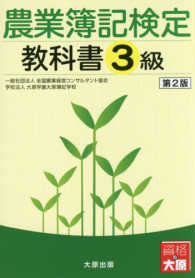- ホーム
- > 洋書
- > 英文書
- > Nature / Ecology
Full Description
Cultural understandings of soil are diverse and often ambiguous. Cultural framing of soils is common worldwide and is highly consequential. The implications of what place the earth has in people's world view and everyday life can be in line with or in conflict with natural conditions, with scientific views, or with agricultural practices. The main assumption underlying this work is that soil is inescapably perceived in a cultural context by any human. This gives emergence to different significant webs of meaning influenced by religious, spiritual, or secular myths, and by a wide range of beliefs, values and ideas that people hold in all societies. These patterns and their dynamics inform the human-soil relationship and how soils are cared for, protected, or degraded.
Therefore, there is need to deal inter-culturally with different sources and types of knowledge and experience regarding soil; a need to cultivate soil awareness and situationally appropriate care through inter- andintra-cultural dialogues and learning. This project focuses on the human and intangible dimensions of soil.
To serve this aim, the International Union of Soil Sciences (IUSS) founded a working group on Cultural Patterns of Soil Understanding that has resulted in this book, which presents studies from almost all continents, written by soil scientists and experts from other disciplines. A major objective of this project is to promote intercultural literacy that gives readers the opportunity to appreciate soil across disciplinary and cultural boundaries in an increasingly globalized world. . .
Contents
A. Introduction to Cultural Soil Dimensions.- 1. Which soil and which cultural approach? All editors, in preparation.- B. World Cultures: Religious, Spiritual and Other Worldviews on Soils.- 2. Cultural patterns of soil cultivation in Europe (3 parts) Nikola Patzel. Chapters in revision.- 2.1 Polytheistic context.- 2.2 Monotheistic context.- 2.3 Scientific context, and organic notions.- 3. Soil in the shamanism mythology and rituals in Northern Eurasia Pavel Krasilnikov. Completed.- 4. From Native American tradition to modern day America, Native origin legends that involve soil and Earth Jeffrey Homburg, Sabine Grunwald, and Eric Brevik. (Sample chapter available below).- 5. The Dogon: The creation of consciousness through agriculture Eva Wertenschlag-Birkhäuser. Completed.- 6. The Yoruba pedosphere: The tale of Onilé Guilherme Sobrinho and Nilton Silva. In revision.- 7. Importance of soil in Islam, a study based on statements in the Quran Mohsen Makki and Jérôme Juilleret. In revision.- 8. Soil in Rumi's thoughts Seyed Kazem Alavipanah, Jafar Jafarzadeh, and Kolsoum Ghazanfari. In revision.- 9. Cultural understanding of soil in China Sylvia Xiaorui Wen. Completed.- 10. Cultural understanding of soil from a Japanese perspective Hideaki Hirai and Katsuyuki Minami. Completed.- 11. Ecosattvas and Ecodharma - Modern Buddhist perspectives of soil and the environment Sabine Grunwald. Completed.- 12.Technosol cultures: New cultural understandings of urban soils Germain Meulemans. Completed.- C. Politics on Soil.- 13. Sacred soil, divine labor: Economic theology and the agrarian political in Eastern India Milinda Banerjee. In revision.- 14. A deity we belong to or a property to own? Land & people relations in Buryat communities of the Sayan mountains Tatiana Intigrinova. Completed.- D. Case Studies on the Inner Soil of Individual Scientists.- 15. The salt of the earth": Bernard Palissy (1510-1590) between soil science and religion Christian Feller, Jean-Paul Aeschlimann, and Nikola Patzel. Chapter in revision.- 16. Darwin and the earthworm: From God the father to mother earth Christian Feller, Laurence Feller Giraud, and Nikola Patzel. Chapter in revision.- E. Conceptual approaches and ethical perspectives.- 17. Inner and Outer soil. Nikola Patzel. In revision.- 18. Soil care: From intention to action Anna Krzywoszynska. Chapter completed.- 19. Soil care, culture and eco-identities Sabine Grunwald and Kay R. Kastner-Wilcox. Completed.- 20. Take care of soils: Toward a pluralistic integral soil ethics Sabine Grunwald. Completed.- F. Soil Education and Cultural Language of the Soil.- 21. Roots of soil perceptions by university and secondary school's students in Minas Gerais, Brazil Cristine C. Muggler, Arthur S. Gasparini and Débora C.L. dos Santos. Chapter in revision.- 22. Degrees pursued by students in different countries to train for careers in soil science Eric C. Brevik, Damien Field, Jacqueline Hannam, Maja Krzic, Rainer Horn, Cristine Muggler, Jude Odhiambo, Yoshitaka Uchida, Danny Itkin, Hong-sheng Wu, Liana Pozza, Laura Bertha Reyes Sánchez, and Thomas Scholten. Chapter completed.- 23. Proverbs on soils Jay E. Yang, H.S. Kim, P. Borrelli and M.B. Kirkham. Chapter completed.- G. Concluding Remarks and Outlook.- 24. Conclusions Nikola Patzel, Eric Brevik, Sabine Grunwald, and Christian Feller. Chapter in preparation.








